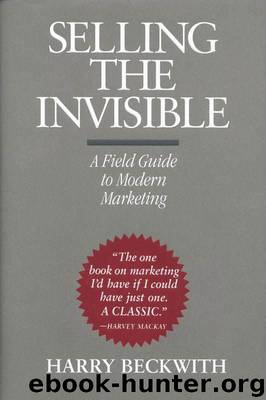Selling the Invisible: A Field Guide to Modern Marketing (Biz Books to Go) by Beckwith Harry

Author:Beckwith, Harry [Beckwith, Harry]
Language: eng
Format: mobi
Tags: BUS058000
Publisher: Business Plus
Published: 1999-06-13T16:00:00+00:00
Focus: What Sears May Have Learned
If you are old enough to remember when bankers were the big shots in every town and when Univac was the world’s most famous computer, you also remember when Sears was America’s Department Store.
Years later, bankers have been the victims of inertia, Univac is a memory, and Sears is a near-casualty of the focus wars in department stores.
Amazingly, even while Americans seem more interested in austerity, Neiman Marcus appears to be thriving, thanks to a position that can best be described, as a Neiman’s shopper might, as the purveyor of “Stuff to die for !” Wal-Mart is the terror of every small-town retailer, thanks to an equally clear focus on “Good stuff so damn cheap you won’t believe it.” And Bloomingdale’s, while not the super-nova it was in the eighties, still attracts a good business by focusing on “Shopping as entertainment.”
Sears, in the first half of the 1990s, on the other hand, became the victim of focusing on nothing—or more accurately, on everything. Sears had always touted its high quality (but horribly low margin), durable goods such as lawn mowers. Now Sears started stressing its “softer side,” its clothing and linens—a difficult marketing combination.
Sears started with very low prices. Then, hoping to improve margins and attract what executives thought was a growing and lasting supply of cost-be-damned Yuppies, they tried to move prices up. Sears tried a little of this and a little of that—and in the middle of the decade, no American within two blocks of the Sears Tower could describe Sears’s position. And if no prospect can describe your position, you do not have one.
Sears quickly discovered that if you do not have a focus, you soon might not have a business. Sales and profits plummeted. The store put its famous tower on the market and moved to more affordable quarters. All that made Sears tolerable to its shareholders were the corporation’s Repair Centers, All-State Insurance, the Discover Card, and the underlying value of the company’s real holdings.
In late 1995, however, the stores showed signs of rallying. By December 1995 same-store sales increased almost six percent despite a sluggish retail economy. Sears’s major weapon in the rebound was an intense focus on the store’s “softer side.” Executives decided to let the impressive word of mouth for Sears’s durable goods drive that portion of its business. They moved furniture out into separate free-standing furniture stores. Then, with aggressive “softer side” advertising, the addition of more national clothing brands, wider aisles, softer lighting, and fancier displays, they drove up women’s clothing sales 10 percent—an important improvement for a chain in which women make more than 70 percent of the purchases.
At this writing, it appears that Sears’s focus on the softer and higher margin portion of its business might revive the stores. (Though one could also argue that Sears owns a unique “one-stop shopping” niche that has great appeal in this age of time-strapped consumers.)
In any case, if Sears had not found this focus, this section would not be subtitled “What Sears May Have Learned.
Download
This site does not store any files on its server. We only index and link to content provided by other sites. Please contact the content providers to delete copyright contents if any and email us, we'll remove relevant links or contents immediately.
Influence: The Psychology of Persuasion by Robert B. Cialdini(4715)
The Miracle Morning by Hal Elrod(4637)
The Hacking of the American Mind by Robert H. Lustig(4318)
Pre-Suasion: A Revolutionary Way to Influence and Persuade by Robert Cialdini(4150)
Unlabel: Selling You Without Selling Out by Marc Ecko(3589)
Ogilvy on Advertising by David Ogilvy(3510)
Hidden Persuasion: 33 psychological influence techniques in advertising by Marc Andrews & Matthijs van Leeuwen & Rick van Baaren(3472)
Purple Cow by Seth Godin(3141)
Who Can You Trust? by Rachel Botsman(3088)
Kick Ass in College: Highest Rated "How to Study in College" Book | 77 Ninja Study Skills Tips and Career Strategies | Motivational for College Students: A Guerrilla Guide to College Success by Fox Gunnar(3075)
The Marketing Plan Handbook: Develop Big-Picture Marketing Plans for Pennies on the Dollar by Robert W. Bly(2975)
This Is Marketing by Seth Godin(2972)
I Live in the Future & Here's How It Works by Nick Bilton(2935)
The Power of Broke by Daymond John(2898)
Building a StoryBrand by Donald Miller(2842)
The Tipping Point by Malcolm Gladwell(2827)
The 46 Rules of Genius: An Innovator's Guide to Creativity (Voices That Matter) by Marty Neumeier(2796)
Draw to Win: A Crash Course on How to Lead, Sell, and Innovate With Your Visual Mind by Dan Roam(2735)
Market Wizards by Jack D. Schwager(2643)
